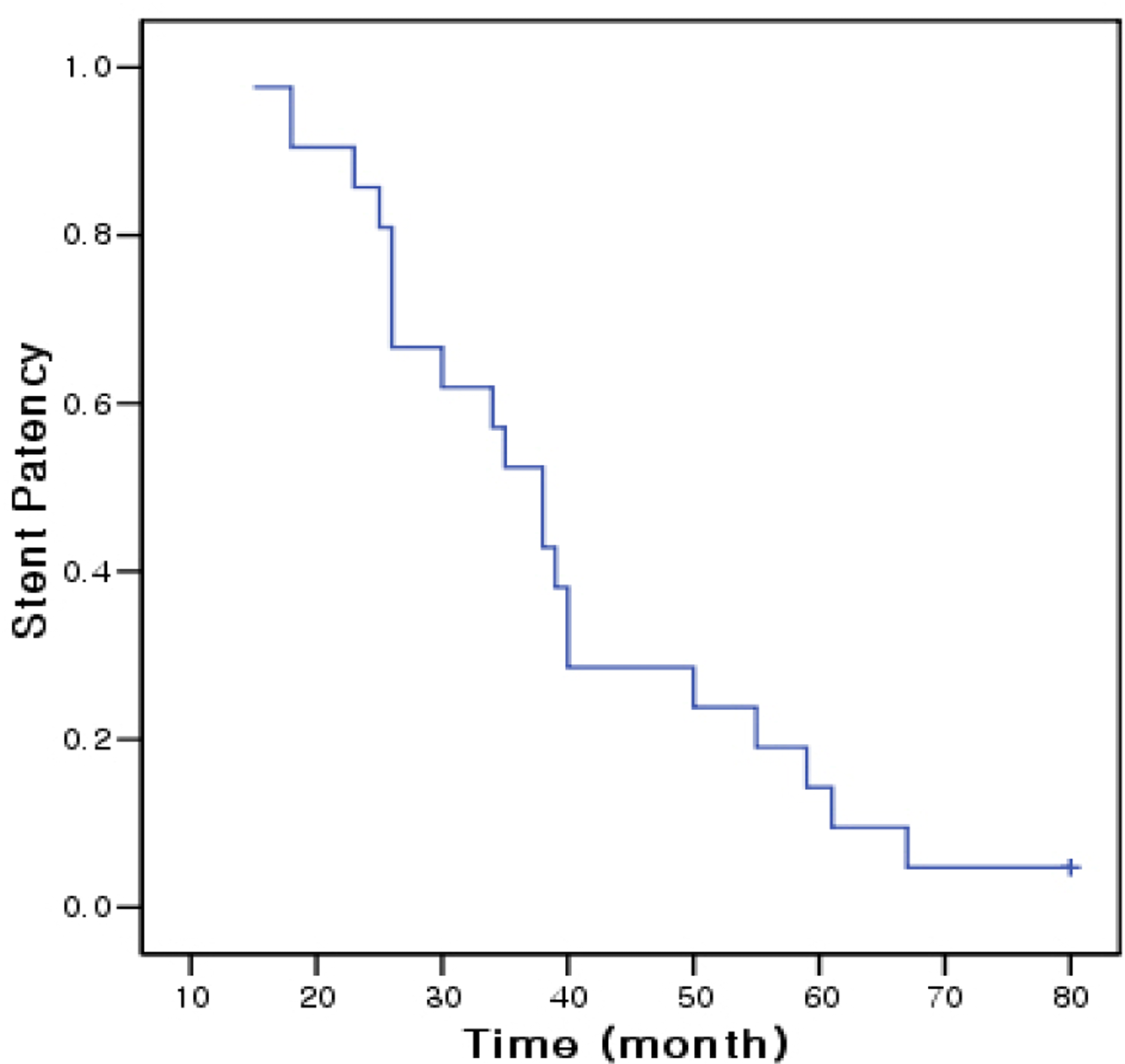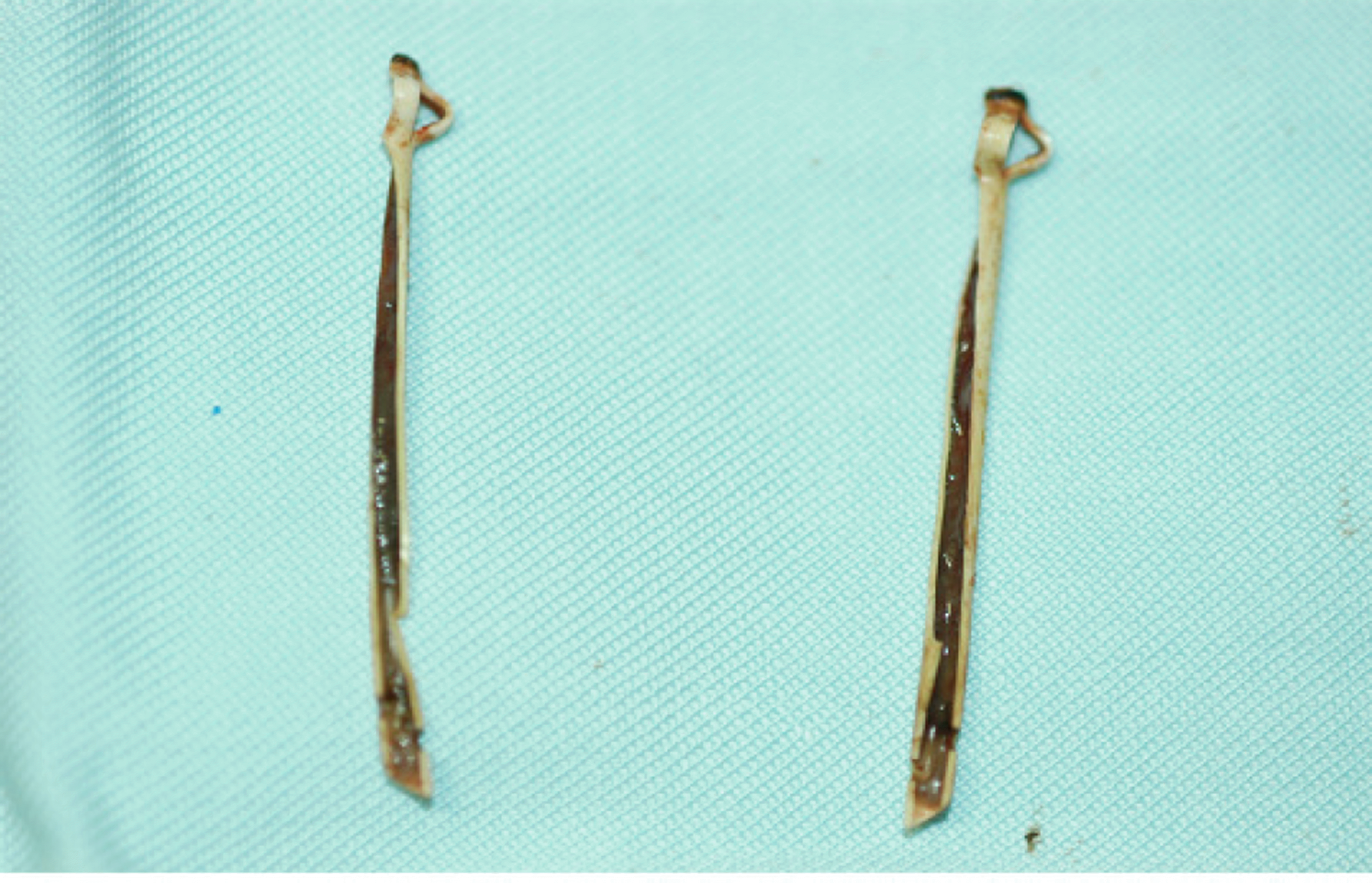Abstract
Purpose
This study was carried out to evaluate and investigate the long-term outcome of placement of 25 plastic nasolacrimal stents (Song's stents) without fluoroscopic guidance for the treatment of obstructed nasolacrimal ducts.
Methods
The medical records of 25 patients who had had Song’s polyurethane stents placed between 1997 and 2003 were reviewed. The patients included 17 women and 8 men who ranged in age from 22 to 79 years (mean, 57.9 years). The mean follow-up period was 54 months.
Results
The overall technical success in this study was 92% (23 of 25 eyes), with a 91% (21 of 23 eyes) short-term success rate. Of the 21 stents deployed, at the end of this study, 20 stents (95%) had been occluded. The median duration of stent patency was 38 months. The interquartile range of stent patency (75%∼25%) were 26 and 50 months, respectively.
Conclusions
Although nasolacrimal stenting with Song's stents is a relatively simple and safe procedure and is a useful alternative in elderly patients or patients in poor general condition, nasolacrimal stenting with Song’s stents does not meet the requirement of long-term efficacy for epiphora resolution.
Go to : 
References
1. Munk PL, Lin DT, Morris DC. Epiphora; treatment by means of dacryocystoplasty with ballon dilatation of the nasolacrimal drainage apparatus. Radiology. 1990; 177:687–90.
2. Sohn HY, Hur J, Chung EH, Won IG. Clinical Observation on Silicone Intubation in Obstruction of Lacrimal Drainage System. J Korean Ophthalmol Soc. 1990; 31:135–40.
3. Song HY, Jin YH, Kim JH. . Nasolacrimal duct obstruction treated nonsurgically with use of plastic stents. Radiology. 1994; 190:535–9.

4. Kim BO, Jin KH, Oh JH. Clinical observation on nasolacrimal duct stent intubation in obstruction of nasolacrimal system. J Korean Ophthalmol Soc. 1995; 36:994–9.
5. Lee JS, Jeong G, Lee SH. . Treatment of obstructed nasolacrimal duct by lacrimal stent without fluoroscopic guidance. J Korean Ophthalmol Soc. 1996; 37:2125–31.
6. Toti A. Nuovo metodo conservatore di cura radicale delle suppuraxioni croniche del sacco lacrimale(Dacriocistorinostomia). Clin Mod Firenze. 1904; 10:385–7.
7. Hausler R, Caversaccio M. Microsurgical endonasal dacryocy- storhinostomy with long-term insertion of bicanalicular silicone tubes. Arch Otolaryngo Head Neck Surg. 1998; 124:188–91.
8. Neuhaus RW. Orbital complications secondary to endoscopic sinus surgery. Ophthalmology. 1990; 97:1512–8.

9. Cunningham MJ, Woog JJ. Endonasal endoscopic dacryocy- storhinostomy in children. Arch Otolaryngol Head Neck Surg. 1998; 124:328–33.
10. Woog JJ, Metson M, Puliafito CA. Holmium: YAG endonasal laser dacryocystorhinostomy. Am J Ophthalmol. 1993; 116:1–10.

11. Boush GA, Lemke BN, Dortzbach RK. Results of endonasal laser assisted dacryocystorhinostomy. Ophthalmology. 1994; 101:955–9.
12. Kong YT, Kim TI, Kong BW. A report of 131 cases of endoscopic laser lacrimal surgery. Ophthalmology. 1994; 111:152–7.

13. Lee SH, Chung WS. Long Term Surgical Efficacy of Endonasal Dacryocystorhinostomy. J Korean Ophthalmol Soc. 2000; 41:307–13.
14. Rice DH. Endoscopic intranasal dacryocystorhinostomy results in four patients. Arch Otolaryngol Head Neck Surg. 1990; 116:1061.

15. Song HY, Ahn HS, Park CK. . Complete obstruction of the nasolacrimal system. Part I: treatment with balloon dilation. Radiology. 1993; 186:367–71.
16. Lee JM, Song HY, Han YM. . Balloon dacryocystoplasty: results in the treatment of complete and partial obstruction of the nasolacrimal system. Radiology. 1994; 192:503–8.
17. Wright KC, Wallace S, Charnsangavej C. . Percutaneous endovascular stents; an experimental evaluation. Radiology. 1985; 156:69–72.

18. Lee JS, Jung G, Oum BS. . Clinical efficacy of the polyurethane stent without fluoroscopic guidance in the treatment of nasolacrimal duct obstruction. Ophthalmology. 2000; 107:1666–70.

19. Yazici B, Yazici Z, Parlak M. Treatment of nasolacrimal duct obstruction in adults with polyurethane stent. Am J Ophthalmol. 2001; 131:37–43.

20. Ozturk S, Konuk O, Ilgit ET. . Outcome of patients with nasolacrimal polyurethane stent implantation: do they keep tearing? Ophthal Plast Reconstr Surg. 2004; 20:130–5.
Go to : 
 | Figure 1.Song's nasolacrimal duct stent set. a. Ball guide wire (W); b. Stent kit=Teflon sheath (T), Lacrimal stent (L), Pusher catheter (P); c. Lacrimal hook (H) |
 | Figure 2.Kaplan-Meier curve shows the cumulative stent patency rate. (median, 38 months; interquartile range, 26∼50 months) |
Table 1.
Data for 25 patients with nasolacrimal obstruction
| Age/Sex | Symptom duration | Cause | Technical success* | Short-term success† | Follow-up (mo) | Duration of stent patency (mo) |
|---|---|---|---|---|---|---|
| 74/M | 15 y | idiopathic | yes | yes | 28 | 25 |
| 67/F | 5 y | idiopathic | yes | yes | 19 | 15 |
| 48/M | 7 y | trauma | yes | no | - | - |
| 74/F | 10 y | idiopathic | yes | yes | 50 | 38 |
| 78/F | 21 y | idiopathic | yes | yes | 40 | 39 |
| 54/F | 4 y | idiopathic | yes | yes | 28 | 26 |
| 64/F | 7 y | idiopathic | yes | yes | 46 | 40 |
| 62/F | 5 y | idiopathic | yes | yes | 60 | 50 |
| 57/M | 3 y | idiopathic | yes | yes | 68 | 67 |
| 44/F | 14 y | idiopathic | no | - | - | - |
| 52/M | 3 y | idiopathic | yes | yes | 47 | 34 |
| 79/F | 2 y | idiopathic | yes | yes | 37 | 35 |
| 28/F | 8 mo | idiopathic | yes | no | - | - |
| 60/M | 9 y | idiopathic | yes | yes | 39 | 38 |
| 60/F | 1 y | trauma | yes | yes | 29 | 23 |
| 23/F | 10 y | idiopathic | yes | yes | 69 | 61 |
| 44/F | 5 y | idiopathic | yes | yes | 36 | 26 |
| 59/F | 5 y | idiopathic | yes | yes | 81 | 80 |
| 62/M | 12 y | idiopathic | yes | yes | 64 | 59 |
| 62/M | 12 y | idiopathic | yes | yes | 42 | 40 |
| 45/F | 1 y | idiopathic | yes | yes | 33 | 30 |
| 67/F | 3 y | idiopathic | yes | yes | 19 | 18 |
| 68/M | 7 y | idiopathic | yes | yes | 57 | 55 |
| 58/F | 4 y | idiopathic | yes | yes | 29 | 26 |
| 22/F | 6 mo | trauma | no | - | - | - |




 PDF
PDF ePub
ePub Citation
Citation Print
Print



 XML Download
XML Download